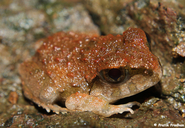|
Sphaerotheca breviceps (Schneider, 1799)
Burrowing frog | family: Dicroglossidae subfamily: Dicroglossinae genus: Sphaerotheca |
 © 2012 Pratik Pradhan (1 of 8) |
|
|
|
Description Color: Dorsum olive golden, with a light yellow median line; a well marked large golden ocellus on shoulder on each side, continuing obliquely along flanks. Indistinct yellowish bars on limbs and jaws. Sometimes its dorsum is faintly mottled. Ventrum cream, gular region black in breeding males. The eyes of juvenile Tomopterna breviceps are surrounded by a dark circle. Its broad head is reddish. Distribution and Habitat Country distribution from AmphibiaWeb's database: Bangladesh, India, Myanmar, Nepal, Pakistan
Life History, Abundance, Activity, and Special Behaviors Breeding season starts with the first showers of summer monsoons, when males gather in the shallow marginal waters of large ponds, spaced well apart from each other. The call is a quickly repeated "Awang, awang, awang" uttered 5 to 7 times in a burst. The same habitat is a potential breeding site for other local amphibians, e.g., Bufo stomaticus, Euphlyctis cyanophlyctis, Holobatrachus tigerinus and Microhyla ornata. Occasionally, a relatively agile male of B. stomaticus or E.cyanophlyctis pairs with a Tomopterna breviceps (regardless of sex) which being docile, offers little or no resistance; the pair soon separates. Eggs of Tomopterna breviceps are large, enclosed in two envelopes of jelly, and laid in small batches which float and adhere to the grass blades. Tomopterna breviceps has a remarkable resemblance to the burrowing frogs of the genus Uperodon. Larva The tadpole is found in small ponds and side pools along streams. Comments For references in the text, see here
References
Khan, M.S. (1976). '' An annotated checklist and key to the amphibians of Pakistan.'' Biologia , 22:201-210. Khan, M.S. (1985). ''An interesting collection of amphibians and reptiles from Cholistan Desert, Punjab, Pakistan.'' Journal of the Bombay Natural History Society, 82, 144-148. Minton, S.A. (1962). ''An annotated key to the amphibians and reptiles of Sind and Las Bela, West Pakistan.'' American Museum Novitates, 2081, 1-21. Minton, S.A. (1966). ''A contribution to the herpetology of West Pakistan.'' Bulletin of the American Museum of Natural History, 134(2), 31-184. Originally submitted by: M. S. Khan (first posted 2002-03-19) Edited by: VTV, JG, Michelle S. Koo (2022-08-15) Species Account Citation: AmphibiaWeb 2022 Sphaerotheca breviceps: Burrowing frog <https://amphibiaweb.org/species/5197> University of California, Berkeley, CA, USA. Accessed Apr 18, 2024.
Feedback or comments about this page.
Citation: AmphibiaWeb. 2024. <https://amphibiaweb.org> University of California, Berkeley, CA, USA. Accessed 18 Apr 2024. AmphibiaWeb's policy on data use. |



 Map of Life
Map of Life